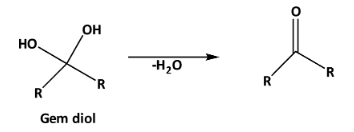
Which of the following gem diols is stable?
A. \[\;C{H_3} - C{\left( {OH} \right)_2} - H\]
B. \[\;CB{r_3} - C{\left( {OH} \right)_2} - H\]
C. \[\;C{F_3} - C{\left( {OH} \right)_2} - H\]
D. \[\;{C_6}{H_5} - C{\left( {OH} \right)_2} - {C_6}{H_5}\]
Answer
123.6k+ views
Hint: Alcohol is an organic compound in which the hydroxyl group is bound with a saturated carbon atom. Primary alcohol(ethanol) is used as a drug. Based on the number of \[ - OH\] groups there are two kinds of alcohol, one is gem diol and the other one is a vicinal diol.
Complete step by step answer:
When the two \[ - OH\] groups are attached at the same carbon of the organic compound then it is called gem diol. And when the \[ - OH\] groups are in two different but neighboring carbon then it is called vicinal diol.
The gem diols are less stable than vicinal diols
The stability of gem diols can be increased in the presence of the electron-withdrawing group at the alpha position. +I effect decreases the stability of the gem diol and increases the extent of dehydration as follows.

And -I effect increases the stability of gem diol. As well as the intramolecular hydrogen bonding also increases the stability of gem diol.
In the case of \[\;C{H_3} - C{\left( {OH} \right)_2} - H\] the methyl group shows the positive inductive effect, as a result, the stability decreases, and dehydration of this gem diol takes place.
In the case of \[\;{C_6}{H_5} - C{\left( {OH} \right)_2} - {C_6}{H_5}\] the two phenyl groups show a positive resonance effect, as a result, the stability decreases, and dehydration of this gem diol takes place.
In the case of \[\;CB{r_3} - C{\left( {OH} \right)_2} - H\] the electronegativity of bromine is less, as a result, the stability decreases, and dehydration of this gem diol takes place.
But in case of \[\;C{F_3} - C{\left( {OH} \right)_2} - H\] due to the highest electronegativity of fluorine this gem diol is stable.
Therefore, considering the stability factor of gem diol the most stable gem diol is \[\;C{F_3} - C{\left( {OH} \right)_2} - H\].
The correct answer is C.
Note: The vicinal diols can be formed by oxidation of the double bonds. For example, when acidified \[\;KMn{O_4}\] reacts with cyclohexene oxidation of the double bonds takes place and vicinal diol is formed as follows,

Complete step by step answer:
When the two \[ - OH\] groups are attached at the same carbon of the organic compound then it is called gem diol. And when the \[ - OH\] groups are in two different but neighboring carbon then it is called vicinal diol.
The gem diols are less stable than vicinal diols
The stability of gem diols can be increased in the presence of the electron-withdrawing group at the alpha position. +I effect decreases the stability of the gem diol and increases the extent of dehydration as follows.

And -I effect increases the stability of gem diol. As well as the intramolecular hydrogen bonding also increases the stability of gem diol.
In the case of \[\;C{H_3} - C{\left( {OH} \right)_2} - H\] the methyl group shows the positive inductive effect, as a result, the stability decreases, and dehydration of this gem diol takes place.
In the case of \[\;{C_6}{H_5} - C{\left( {OH} \right)_2} - {C_6}{H_5}\] the two phenyl groups show a positive resonance effect, as a result, the stability decreases, and dehydration of this gem diol takes place.
In the case of \[\;CB{r_3} - C{\left( {OH} \right)_2} - H\] the electronegativity of bromine is less, as a result, the stability decreases, and dehydration of this gem diol takes place.
But in case of \[\;C{F_3} - C{\left( {OH} \right)_2} - H\] due to the highest electronegativity of fluorine this gem diol is stable.
Therefore, considering the stability factor of gem diol the most stable gem diol is \[\;C{F_3} - C{\left( {OH} \right)_2} - H\].
The correct answer is C.
Note: The vicinal diols can be formed by oxidation of the double bonds. For example, when acidified \[\;KMn{O_4}\] reacts with cyclohexene oxidation of the double bonds takes place and vicinal diol is formed as follows,

Recently Updated Pages
Classification of Drugs Based on Pharmacological Effect, Drug Action

Types of Solutions - Solution in Chemistry

Difference Between Alcohol and Phenol

JEE Main Participating Colleges 2024 - A Complete List of Top Colleges

JEE Main Maths Paper Pattern 2025 – Marking, Sections & Tips

Sign up for JEE Main 2025 Live Classes - Vedantu

Trending doubts
JEE Main 2025 Session 2: Application Form (Out), Exam Dates (Released), Eligibility & More

JEE Main Exam Marking Scheme: Detailed Breakdown of Marks and Negative Marking

JEE Main 2023 January 24 Shift 2 Question Paper with Answer Keys & Solutions

Learn About Angle Of Deviation In Prism: JEE Main Physics 2025

JEE Main 2025: Conversion of Galvanometer Into Ammeter And Voltmeter in Physics

Physics Average Value and RMS Value JEE Main 2025

Other Pages
NCERT Solutions for Class 12 Chemistry Chapter 6 Haloalkanes and Haloarenes

NCERT Solutions for Class 12 Chemistry Chapter 1 Solutions

NCERT Solutions for Class 12 Chemistry Chapter 2 Electrochemistry

JEE Advanced Marks vs Ranks 2025: Understanding Category-wise Qualifying Marks and Previous Year Cut-offs

NCERT Solutions for Class 12 Chemistry Chapter 7 Alcohol Phenol and Ether

NCERT Solutions for Class 12 Chemistry Chapter 8 Aldehydes Ketones and Carboxylic Acids




